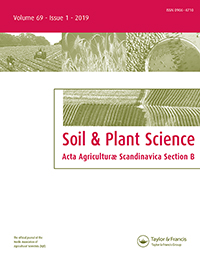Ver ítem
- xmlui.general.dspace_homeCentros e Institutos de InvestigaciónCIAP. Centro de Investigaciones AgropecuariasInstituto de Patología VegetalArtículos científicosxmlui.ArtifactBrowser.ItemViewer.trail
- Inicio
- Centros e Institutos de Investigación
- CIAP. Centro de Investigaciones Agropecuarias
- Instituto de Patología Vegetal
- Artículos científicos
- Ver ítem
Integrated multivariate analysis of selected soil microbial properties and their relationships with mineral fertilization management in a conservation agriculture system
Resumen
The effect of mineral fertilizer application on soil microbial community was investigated in a conservation agriculture system. The aim of this work was to evaluate how mineral fertilization with nitrogen (N), phosphorus (P), sulfur (S), and micronutrients (M) affects microbial community structure and function. A 10-year experiment, conducted on a typic Hapludoll using six mineral fertilizer treatments (control, CK; PS; NS; NP; NPS; and NPSM) was
[ver mas...]
The effect of mineral fertilizer application on soil microbial community was investigated in a conservation agriculture system. The aim of this work was to evaluate how mineral fertilization with nitrogen (N), phosphorus (P), sulfur (S), and micronutrients (M) affects microbial community structure and function. A 10-year experiment, conducted on a typic Hapludoll using six mineral fertilizer treatments (control, CK; PS; NS; NP; NPS; and NPSM) was evaluated in central Argentina. Microbial community structure and function were characterized by phospholipid fatty acids and community-level physiological profiles, respectively. Soil microbial metabolic activity was determined by monitoring microbial respiration, fluorescein diacetate activity (FDA), dehydrogenase activity and phosphatase activity (PHA). NPS and NPSM treatments showed higher total microbial biomass and gram-positive and gram-negative bacteria, but lower fungal biomass than the remaining treatments. Fertilizer treatments without S (CK and NP) showed lower carbon source utilization and Shannon index than the other treatments. In addition, both FDA and PHA significantly increased under NPSM. An integrated PC analysis indicated that sensitive bioindicators were significantly associated with three carbon sources, one metabolic parameter, and six fatty acid bioindicators. These results provide information about the importance of balanced fertilization with P, N, S, and M in promoting microbial biomass, metabolic activity, and functional diversity.
[Cerrar]

Autor
Verdenelli, Romina Aylen;
Conforto, Erica Cinthia;
Perez Brandan, Carolina;
Chavarria, Diego;
Rovea, Adrián;
Vargas Gil, Silvina;
Meriles, Jose Manuel;
Fuente
Acta agriculturae Scandinavica. Section B, soil & plant science 63 (7). (2013)
Fecha
2013
Editorial
Taylor & Francis
ISSN
0906-4710
Formato
pdf
Tipo de documento
artículo
Palabras Claves
Derechos de acceso
Restringido
 Excepto donde se diga explicitamente, este item se publica bajo la siguiente descripción: Creative Commons Attribution-NonCommercial-ShareAlike 2.5 Unported (CC BY-NC-SA 2.5)
Excepto donde se diga explicitamente, este item se publica bajo la siguiente descripción: Creative Commons Attribution-NonCommercial-ShareAlike 2.5 Unported (CC BY-NC-SA 2.5)

